Antimicrobial activity of compounds identified by artificial intelligence discovery engine targeting enzymes involved in Neisseria gonorrhoeae peptidoglycan metabolism
- PMID: 39238057
- PMCID: PMC11375863
- DOI: 10.1186/s40659-024-00543-9
Antimicrobial activity of compounds identified by artificial intelligence discovery engine targeting enzymes involved in Neisseria gonorrhoeae peptidoglycan metabolism
Abstract
Background: Neisseria gonorrhoeae (Ng) causes the sexually transmitted disease gonorrhoea. There are no vaccines and infections are treated principally with antibiotics. However, gonococci rapidly develop resistance to every antibiotic class used and there is a need for developing new antimicrobial treatments. In this study we focused on two gonococcal enzymes as potential antimicrobial targets, namely the serine protease L,D-carboxypeptidase LdcA (NgO1274/NEIS1546) and the lytic transglycosylase LtgD (NgO0626/NEIS1212). To identify compounds that could interact with these enzymes as potential antimicrobials, we used the AtomNet virtual high-throughput screening technology. We then did a computational modelling study to examine the interactions of the most bioactive compounds with their target enzymes. The identified compounds were tested against gonococci to determine minimum inhibitory and bactericidal concentrations (MIC/MBC), specificity, and compound toxicity in vitro.
Results: AtomNet identified 74 compounds that could potentially interact with Ng-LdcA and 84 compounds that could potentially interact with Ng-LtgD. Through MIC and MBC assays, we selected the three best performing compounds for both enzymes. Compound 16 was the most active against Ng-LdcA, with a MIC50 value < 1.56 µM and MBC50/90 values between 0.195 and 0.39 µM. In general, the Ng-LdcA compounds showed higher activity than the compounds directed against Ng-LtgD, of which compound 45 had MIC50 values of 1.56-3.125 µM and MBC50/90 values between 3.125 and 6.25 µM. The compounds were specific for gonococci and did not kill other bacteria. They were also non-toxic for human conjunctival epithelial cells as judged by a resazurin assay. To support our biological data, in-depth computational modelling study detailed the interactions of the compounds with their target enzymes. Protein models were generated in silico and validated, the active binding sites and amino acids involved elucidated, and the interactions of the compounds interacting with the enzymes visualised through molecular docking and Molecular Dynamics Simulations for 50 ns and Molecular Mechanics Poisson-Boltzmann Surface Area (MM-PBSA).
Conclusions: We have identified bioactive compounds that appear to target the N. gonorrhoeae LdcA and LtgD enzymes. By using a reductionist approach involving biological and computational data, we propose that compound Ng-LdcA-16 and Ng-LtgD-45 are promising anti-gonococcal compounds for further development.
Keywords: Neisseria gonorrhoeae; Artificial intelligence; Bactericidal; Computational modelling; Peptidoglycan.
© 2024. The Author(s).
Conflict of interest statement
All authors declare that they have no competing interests.
Figures

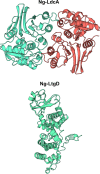


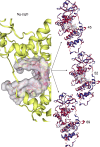

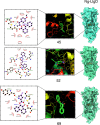
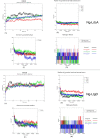

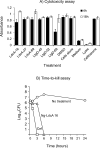

Similar articles
-
Selective Inhibition of Neisseria gonorrhoeae by a Dithiazoline in Mixed Infections with Lactobacillus gasseri.Antimicrob Agents Chemother. 2018 Nov 26;62(12):e00826-18. doi: 10.1128/AAC.00826-18. Print 2018 Dec. Antimicrob Agents Chemother. 2018. PMID: 30275084 Free PMC article.
-
A Single Dual-Function Enzyme Controls the Production of Inflammatory NOD Agonist Peptidoglycan Fragments by Neisseria gonorrhoeae.mBio. 2017 Oct 17;8(5):e01464-17. doi: 10.1128/mBio.01464-17. mBio. 2017. PMID: 29042497 Free PMC article.
-
Bactericidal activity of esculetin is associated with impaired cell wall synthesis by targeting glutamate racemase of Neisseria gonorrhoeae.Mol Divers. 2024 Oct;28(5):3181-3198. doi: 10.1007/s11030-023-10745-0. Epub 2023 Oct 25. Mol Divers. 2024. PMID: 37880544
-
Neisseria gonorrhoeae uses two lytic transglycosylases to produce cytotoxic peptidoglycan monomers.J Bacteriol. 2008 Sep;190(17):5989-94. doi: 10.1128/JB.00506-08. Epub 2008 Jun 20. J Bacteriol. 2008. PMID: 18567658 Free PMC article.
-
Will targeting oropharyngeal gonorrhoea delay the further emergence of drug-resistant Neisseria gonorrhoeae strains?Sex Transm Infect. 2015 Jun;91(4):234-7. doi: 10.1136/sextrans-2014-051731. Epub 2015 Apr 24. Sex Transm Infect. 2015. PMID: 25911525 Review.
Cited by
-
Bactericidal Effect of Synthetic Phenylalkylamides Inspired by Gibbilimbol B Against Neisseria gonorrhoeae.Molecules. 2025 May 30;30(11):2406. doi: 10.3390/molecules30112406. Molecules. 2025. PMID: 40509293 Free PMC article.
-
Strategies and applications of antibacterial surface-modified biomaterials.Bioact Mater. 2025 Jul 9;53:114-140. doi: 10.1016/j.bioactmat.2025.07.009. eCollection 2025 Nov. Bioact Mater. 2025. PMID: 40688018 Free PMC article. Review.
References
-
- Mayor MT, Roett MA, Uduhiri KA. Diagnosis and management of gonococcal infections. Am Fam Phys. 2012;86(10):931–8. - PubMed
-
- Wetzler LM, Feavers IM, Gray-Owen SD, Jerse AE, Rice PA, Deal CD. Summary and recommendations from the National Institute of allergy and infectious diseases (NIAID) workshop “Gonorrhea vaccines: the way forward.” Clin Vacc Immunol. 2016;23(8):656–63. 10.1128/CVI.00230-16.10.1128/CVI.00230-16 - DOI - PMC - PubMed
MeSH terms
Substances
Grants and funding
LinkOut - more resources
Full Text Sources
Medical
Miscellaneous

